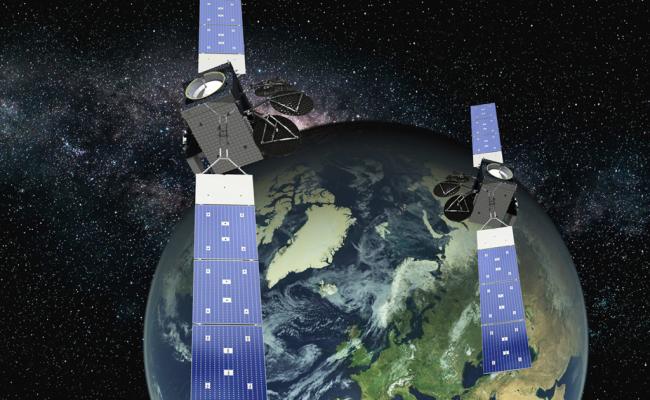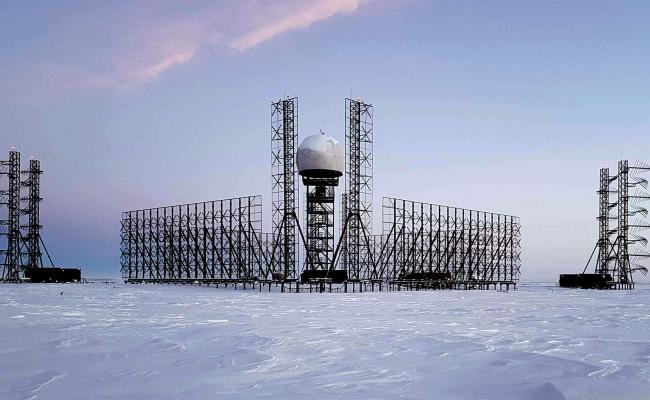Russia Plans to Launch Nine Polar-orbiting Satellites to Monitor the Arctic by 2026

The Northern Sea Route is one of Russian President Vladimir Putin's flagship projects and he recently said that the country is aiming for year-round sailing along this shipping lane. (Photo: climate.nasa.gov)
Russia continues to develop its Arctic infrastructure detailing plans to place nine additional dual-purpose satellites into polar orbits.
Russia’s space agency Roscosmos announced plans to further expand the country’s monitoring and surveillance capabilities in the region.
The country’s deputy prime minister, Yury Trutnev, elaborated that Roscosmos has been tasked with launching two Arktika-M satellites for hydro-meterological monitoring of the region.
In addition it will bring two Kondor-FKAs and a single Obzor-R into a polar orbit, all three for the purpose of radar surveillance, including the ability to monitor the region through cloud cover and at night. All five units will be placed in orbit by 2024.
An additional four satellites referred to as Express-RVs, for the purpose of high speed internet and communications for civilian and military purposes, are scheduled for launch by 2026.
"Our key direction in the Northern Sea Route's development is to have an Arctic orbital satellite group,” explained Trutnev.
We plan another such satellite will be launched in 2023
“Without the creation of an Arctic satellite constellation, the safe passage of ships along the Northern Sea Route is not possible,” he further added.
Monitoring the NSR and Russian Arctic
Russia began expanding its Arctic space-based capabilities in February 2021 with the launch of the first Arktika-M satellite.
In addition to the monitoring of hydro-meterological and environmental conditions, the units are also capable of surveilling the surface of the Arctic Ocean and surrounding landmasses.
Once the second Arktika-M unit has been placed in orbit in 2023, Russia will be able to monitor the area around the North Pole and the length of its Northern Sea Route without interruption in 15 minute intervals, according to Sergei Buyanov, Director General for the Russian Navy Central Research Institute.
"In February 2021, a special Arktika-M satellite was launched. We plan another such satellite will be launched in 2023. Thus, we will be able to cover rather well the entire Northern Sea Route," Buyanov explained.
The current system along the entire NSR is not sufficient
These remote-sensing satellites will allow Russia to enhance domain awareness.
“The current system for monitoring and communication along the entire Northern Sea Route is not sufficient,” the expert stressed.
The Northern Sea Route is Russia’s key Arctic shipping lane providing for export of hydrocarbon resources from the North to Europe and Asia.
Elliptical orbit to cover the Arctic
By placing the satellites in a highly elliptical orbit the satellites are able to provide continuous coverage of the region, unlike geostationary units over the equator, which are ill suited for the Arctic as they are unable to look far enough north.
The Arktika-M satellites are large-size spacecraft weighing in at 2,100 kilograms, with dimensions of four meters across and a 10-meter solar array, similar to the US’ long-running Landsat satellites.
The Arktika-M series is designed for an operational period of seven years.
“Russia has implemented a unique project for the first time in history. The Arktika-M satellite is a pioneering invention and provides unique data,” said Yury Gektin, chief designer at Roscosmos.
Arktika-M will orbit the Earth in an highly elliptical orbit with altitude varying from as low as 1,000 kilometers and as high as 40,000 kilometers.
A total of five Arktika-M satellites are planned
The satellite’s technology will also allow for high-resolution ice monitoring providing ice forecasts with a resolution as low as one kilometer.
A total of five Arktika-M satellites are planned according to Gektin.
The Arktika-M concept goes back to 2007, when the Russian government first discussed the need for reliable communication and navigation as well as monitoring capabilities across the region.
The first launch was originally envisioned for 2013 but technical revisions to provide higher-resolution monitoring led to repeated delays so that the first unit was not deployed until 2021.
Dual-purpose and all weather-capabilities
A recent report on Russia’s space-based assets by the Center for Naval Analyses (CNA), a research and development think tank affiliated with the US Department of Defense, concludes that “Moscow has been investing heavily in military and dual-purpose spacecraft projects in recent years.”
Dual-purpose satellites collect information and data that can serve both civilian and military needs.
Russia has placed a special emphasis on space-based surveillance that provides all-weather, day-and-night radar imaging for the earth’s surface.
In this regard the Obzor-R satellite will be of key importance as it would enhance Russia’s ability to map the Arctic and monitor it for man-made activity, including shipping and mining, during nighttime or through clouds when traditional optical satellites are unable to operate.
The researchers at CNA emphasize that Russia’s ability to successfully deploy radar-imaging satellites, including those targeting the Arctic, “would indicate major progress for both military and civilian space sectors in Russia.”





